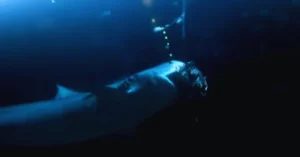Sharks are more active at night, often referred to as nocturnal animals. This article will explore the behaviors and characteristics of sharks during nighttime, including their hunting patterns and adaptations that make them more efficient predators in the darkness.
We will also discuss the reasons behind their enhanced activity levels during the nighttime hours and how this behavior differs from daylight hours. Understanding the activity patterns of sharks can provide valuable insights into their ecological roles and aid in the development of conservation strategies to protect these magnificent creatures.
So, let’s dive into the intriguing world of nocturnal shark behavior and discover why they prefer to roam the oceans under the cover of darkness.
Unveiling The Nighttime Secrets
While sharks are active during the day, their behavior at night may differ. Understanding their nocturnal activity is crucial for gaining a comprehensive understanding of their ecological role and can provide valuable insights into their conservation.
Explanation Of The Topic And Its Significance
Shark behavior is a fascinating field of study that can provide insights into their ecology and evolutionary adaptations. Understanding whether sharks are more active at night is crucial for a variety of reasons. It can help researchers and marine biologists better understand their feeding habits, hunting strategies, and overall behavior patterns.
Additionally, this knowledge can aid in the development of effective conservation strategies to protect these magnificent creatures and the delicate ecosystems they inhabit.
Brief Overview Of Shark Behavior During The Day
During the day, sharks exhibit different behaviors that are influenced by factors such as water temperature, the availability of prey, and their own physiological needs. Here is a glimpse of their behavior during daylight hours:
- Hunting: Sharks are apex predators and are known for their skillful hunting techniques. During the day, they actively search for food, relying on their excellent sense of smell to locate potential prey items.
- Resting: Sharks also spend a significant amount of time resting during the day. They have an incredible ability to remain stationary in the water by using their pectoral fins to maintain balance.
- Thermoregulation: Some species of sharks, such as the white shark, engage in a behavior known as thermoregulation. This involves swimming to warmer surface waters to maintain their body temperature.
Factors Contributing To Nocturnal Activity
Sharks exhibit greater activity during the night due to various factors. The abundance and behavior of prey, as well as water temperature and light intensity, all contribute to their nocturnal behavior. By utilizing the cover of darkness, sharks are able to enhance their hunting efficiency and capitalize on the vulnerabilities of their prey.
Influence Of Prey Availability And Behavior
Limited visibility during nighttime enables sharks to surprise and capture their prey more effectively. Some of the prey species preferred by sharks, such as squids and small fish, are more active at night, making it an opportune time for hunting. The cover of darkness provides sharks with a strategic advantage, allowing them to approach their prey unnoticed.
Role Of Water Temperature And Light Intensity
Water temperature is a significant factor influencing shark behavior. Many species tend to be more active in warmer waters, which are more prevalent during the day. Cooler water temperatures at night may provide a more comfortable environment for sharks, leading to increased activity. Light intensity, or rather the lack thereof, plays a crucial role in sharks’ preference for nighttime hunting. Since most prey species rely on light for their own survival and use it to navigate, sharks take advantage of the darkness to ambush them.
Adaptations For Nighttime Hunting
Sharks have developed remarkable adaptations for nighttime hunting. From their enhanced sensory capabilities, such as electroreception and the ampullae of lorenzini, to their stealthy movements and ambush techniques, sharks have found ways to thrive in the darkness.

These adaptations not only give them an advantage when it comes to hunting, but they also highlight the incredible diversity and resilience of these fascinating apex predators.
Enhanced Sensory Capabilities Of Sharks:
- Electroreception: Sharks possess an incredible sense called electroreception, which allows them to detect electrical fields produced by their prey. This ability is particularly useful during the nighttime when visibility is reduced. By sensing the weak electrical signals generated by their potential meals, sharks can home in on their unsuspecting prey even in the darkest of waters.
- Ampullae of lorenzini: Sharks also have a specialized sensory system known as the ampullae of lorenzini. These tiny, jelly-filled pores located on the shark’s snout are extremely sensitive to small changes in temperature and electrical currents. This enables the shark to detect even the slightest movements made by their prey, giving them a distinct advantage in the dark.
- Lateral line system: Another adaptation that aids sharks in their nocturnal hunting is their lateral line system. This network of sensory cells, located along the sides of their body, allows sharks to detect changes in water pressure and vibrations caused by nearby movement. This heightened sensitivity helps them locate prey even when visibility is low.
Stealth And Ambush Techniques Used By Sharks:
- Camouflage: Many nocturnal sharks possess dark-colored or patterned skin that helps them blend into the shadows of the ocean floor. This camouflage allows them to ambush unsuspecting prey and launch surprise attacks. By remaining undetected until the last moment, sharks maximize their chances of capturing a meal in the darkness.
- Slow and deliberate movements: Unlike their diurnal counterparts, nocturnal sharks are known for their slow and calculated movements. By moving quietly and slowly, they avoid creating disturbances or alerting their prey to their presence. This stealthy behavior allows sharks to get closer to their victims before striking, increasing their chances of a successful hunt.
- Vertical hunting: Some sharks adopt a vertical hunting strategy at night, patrolling the water column from the depths to the surface. This tactic takes advantage of the fact that many prey animals migrate vertically during the nighttime hours. By positioning themselves strategically, sharks increase the likelihood of encountering potential meals as they ascend or descend.
Behavioral Differences Between Shark Species
Understanding the behavior of different shark species and their hunting preferences gives us valuable insights into their fascinating lives. While some sharks are indeed more active at night, others exhibit different hunting behaviors, making each species a unique marvel in the underwater world.
Variations In Nocturnal Hunting Preferences
Sharks exhibit a wide range of hunting behaviors, and these can vary among different species. Some sharks are more active at night, while others prefer to hunt during the day. Nocturnal species of sharks often have adaptations that enable them to navigate and hunt effectively in low-light conditions. They may have larger eyes, enhanced vision, or a heightened sense of smell to locate prey.
Many shark species are known to display crepuscular behavior, which means they are most active during twilight hours, as the sun sets or rises. This offers them the advantage of catching prey that may be more abundant during these transitional periods. Environmental factors, such as tides and currents, also influence the hunting behavior of sharks. For instance, some species may take advantage of strong tidal movements at night to ambush their prey.
The availability of prey can also affect the hunting patterns of sharks. If certain types of prey are more abundant at night, sharks that feed on them are likely to be more active during those hours.
Examples Of Specific Shark Species And Their Behavior At Night
- Tiger sharks: These sharks are known for their opportunistic feeding habits and are considered nocturnal hunters. They actively search for prey during the night, leveraging their excellent sense of smell and variety of food sources.
- Great white sharks: Contrary to popular belief, great whites are not exclusively diurnal or nocturnal. They display a combination of diurnal and crepuscular behaviors, often hunting during dawn or dusk when visibility is low.
- Hammerhead sharks: These distinctive sharks are known for their unique head shape. Some hammerhead species, such as the scalloped hammerhead, exhibit strong nocturnal tendencies and are more active in the darker hours.
- Nurse sharks: Nurse sharks are generally nocturnal creatures, spending their days resting in caves or under ledges. When night falls, they become more active and venture out to hunt for bottom-dwelling prey.
- Whitetip reef sharks: Whitetip reef sharks are predominantly nocturnal, spending their days resting in caves or under coral ledges. As dusk approaches, they emerge to hunt on the reef, taking advantage of the cover of darkness.
Research Studies And Findings
Research studies have provided valuable insights into the activity patterns of sharks at different times of the day. While many shark species exhibit a preference for nocturnal activity, others engage in diurnal hunting behavior. These findings have implications for ecological understanding, conservation efforts, tourism, and public safety.
Studies Focused On Shark Activity At Different Times Of The Day
Researchers have conducted numerous studies to gain insights into the activity patterns of sharks at varying times. These studies have shed light on the behavior of different shark species, providing valuable information for both scientists and curious individuals. Key findings include:
- Nocturnal preference: Several studies have indicated that a significant number of shark species are more active during the night. These sharks exhibit a tendency to hunt and feed under the cover of darkness, taking advantage of reduced visibility to prey on unsuspecting marine life.
- Diurnal behavior: While a considerable portion of sharks display nocturnal hunting behavior, it’s important to note that not all species exhibit this pattern. Some sharks, such as the great white shark, have been observed to actively hunt during the day as well. This diurnal behavior suggests that different factors, such as habitat, prey availability, and individual characteristics, influence the activity patterns of sharks.
- Location-dependent activity: Studies have highlighted that shark activity can also vary depending on geographical location. For instance, in certain areas where prey abundance is higher during daylight hours, sharks may adjust their activity patterns accordingly. This emphasizes the importance of considering regional differences when examining shark behavior across different times of the day.
Scientific Findings And Their Implications
The scientific findings regarding shark activity at different times of the day have significant implications for both researchers and the general public. Here are some key takeaways:
- Ecological understanding: Understanding the activity patterns of sharks provides crucial insights into their ecological role within marine ecosystems. By comprehending when and how sharks hunt, researchers can further investigate the predator-prey dynamics and overall biodiversity of these ecosystems.
- Conservation considerations: The findings on shark activity patterns can greatly contribute to conservation efforts. Knowing when sharks are most active can aid in the development of effective conservation strategies, such as implementing fishing regulations and establishing protected areas during peak activity times to mitigate potential conflicts between sharks and human activities.
- Tourism opportunities: For those interested in shark ecotourism, knowing the activity patterns of these magnificent creatures can enhance the overall experience. By offering shark diving or viewing excursions during their peak activity periods, tour operators can increase the chances of observing these majestic creatures in their natural habitat.
- Public perception and safety: Understanding the temporal behavior of sharks can also help reshape public perception. By disseminating accurate information about the activity patterns of different shark species, it is possible to promote a more balanced perspective and reduce unnecessary fear or panic surrounding shark encounters. Additionally, this knowledge can assist in promoting guidelines for beach safety and shark-human coexistence.
Potential Risks For Humans

Remember, while the fear of shark encounters is understandable, the vast majority of shark species pose no threat to humans. By taking necessary precautions, understanding their behavior, and respecting their natural habitat, we can coexist with these incredible creatures safely.
Increased Chances Of Shark Encounters At Night
While it is true that some shark species are more active during the nighttime hours, particularly those that typically inhabit deeper waters, it doesn’t necessarily mean that the risk of encounters with humans is significantly higher after dark. However, there are a few reasons why sharks may seem more active at night:
- Feeding behavior: Certain species of sharks, such as the great white shark, are known to feed primarily during the evening and early morning hours. This feeding pattern might give the impression that sharks are more active at night.
- Hunting strategy: Some sharks rely on their keen sense of smell to locate prey, and in low-light conditions, their sense of smell becomes even more heightened. This enhanced ability allows them to hunt more efficiently during the night.
- Natural behaviors: Some sharks are nocturnal by nature, meaning they naturally prefer to be active at night. These species, like the nurse shark, are well adapted to the darker environment and are more actively engaged in seeking food and navigating during nocturnal hours.
Precautions And Safety Measures For Night-Time Activities In Shark-Inhabited Areas
Whether you are planning to go night diving, fishing, or engaging in any other water-related activities in areas known to be inhabited by sharks, it’s important to take necessary precautions to ensure your safety:
- Research and stay informed: Before heading out, familiarize yourself with the shark species present in the area and their behavior patterns. Local authorities, dive shops, and marine biologists can provide valuable information and tips to ensure safer encounters.
- Avoid areas with known shark activity: If possible, it’s best to avoid regions where shark sightings or incidents have been reported. Choose alternative locations that are deemed safer for your desired activities.
- Be mindful of your surroundings: Maintain situational awareness while in the water and keep an eye out for any signs or indications of shark presence. Pay attention to activities like baitfish schools behaving erratically, seals or dolphins swiftly leaving the area, or birds diving into the water, as these may be signs of nearby sharks.
- Stay in groups: Sharks are more likely to approach solitary individuals, considering them as potential prey. By staying in a group, you minimize the chances of being targeted.
- Avoid dusk and dawn activities: Sharks are more active during twilight hours, so it’s advisable to limit your water activities during these times. If you need to be in the water, ensure you take extra precautions during these periods.
- Use proper lighting: If you’re participating in night diving or boating, ensure that you have adequate lighting to improve visibility. Bright lights can deter sharks from approaching too closely.
- Follow local regulations: Always abide by any regulations or guidelines put forth by local authorities or marine conservation organizations. They are in place to protect both humans and marine life.
Incorporating Shark Behavior Studies Into Conservation Strategies
Shark behavior studies play a vital role in shaping conservation strategies that aim to protect these magnificent creatures. By gaining insights into their behavior patterns, scientists and conservationists can develop targeted initiatives for preserving their populations. Here are some key points to consider:
- Tracking technology: Advanced tracking technology, such as satellite tags and acoustic transmitters, allows researchers to monitor the movements and behaviors of sharks. This data provides valuable information on migration patterns, feeding habits, and reproduction cycles, which can guide conservation efforts.
- Nocturnal behavior: While it is true that some shark species are more active at night, not all sharks exhibit this behavior. Studies have shown that certain species, like the great white shark, tend to be more active during twilight hours, while others, such as the tiger shark, may exhibit increased activity throughout the night. Understanding these patterns helps conservationists tailor protective measures to specific species and their habitats.
- Influence of environmental factors: Shark activity can be influenced by various environmental factors, including temperature, prey availability, and moon phases. By studying how these factors impact their behavior, conservationists can better predict and mitigate potential threats to shark populations.
Frequently Asked Questions
Why Do Sharks Come Closer To Shore At Night?
Sharks may come closer to shore at night to search for food, take advantage of darkness for stealth, or follow their prey.
What Is The Advantage Of Shark’S Nocturnal Hunting?
Sharks’ nocturnal hunting allows them to exploit the cover of darkness, when many of their prey are less alert and more vulnerable.
Do Sharks See Better In The Dark?
Sharks possess a remarkable ability to see in low-light conditions, thanks to specialized eye structures and a high concentration of light-sensitive cells.
How Do Sharks Navigate At Night?
Sharks use multiple senses, including their keen sense of smell, electroreception, and a lateral line system, to navigate and locate prey in the darkness of night.
Conclusion
In the world of sharks, the question of whether they are more active at night has been the subject of fascination and debate. Through the research conducted in this blog post, we have explored the different factors that contribute to a shark’s activity patterns.
From their evolutionary history to their hunting and feeding behaviors, it is evident that sharks exhibit a variety of activity patterns depending on the species and their specific environments. While some species, like the great white shark, have been observed to be more active during the day, others, like the hammerhead shark, tend to be more nocturnal.
This suggests that there is no one-size-fits-all answer to whether sharks are more active at night or during the day. Ultimately, understanding the activity patterns of sharks is crucial for marine biologists and researchers, as well as for individuals who navigate the ocean waters.





